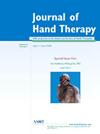Exploring the reasons behind the low focus on upper limb rehabilitation in the early stages after a stroke: A qualitative study
IF 1.8
4区 医学
Q2 ORTHOPEDICS
引用次数: 0
Abstract
Background
One aspect that is often impaired in people living with stroke is the motor function of the upper limb.
Purpose
To explore the reasons behind the low focus on upper limb rehabilitation after stroke and to understand the views of rehabilitation professionals (RPs) on the use of upper limb rehabilitation technologies for self-management of stroke.
Study Design
A qualitative descriptive design that employs a one-on-one semistructured interview method.
Methods
A total of nine RPs (physiotherapist n = 6 and occupational therapist n = 3) participated. Interviews were held in person or via teleconferencing, recorded, and transcribed verbatim. All transcribed data were analyzed using thematic analysis, with an inductive approach.
Results
The average length of practice years of the RPs in this study was 24.7 ± 9.8, with 16.44 ± 9.19 experience in neurological rehabilitation. The views gathered from all nine (9/9) RPs point to a low focus on upper limb rehabilitation for people living with stroke. In an inpatient setting, this was attributed to the rehabilitation goals/ priorities (of people living with stroke, RPs, and/or hospital’s rehabilitation/stroke units), inadequate resources, and the inability of the RPs to deal with the high incidence of stroke. After discharge, it was attributed to the cost of securing private rehabilitation and poor knowledge of technologies that can support self-rehabilitation. The cost, design, and inadequacy of evidence on the effectiveness of some available upper limb rehabilitation technologies were noted as reasons that could make it difficult for RPs to promote the use of rehabilitation technologies.
Conclusions
There is a low focus on upper limb rehabilitation after a stroke, particularly during the early stages, owing to the pursuit of early discharge which appears to attach higher priority to the lower limb in addition to inadequate resources and lack of capacity to deal with the high incidence of stroke.
探索中风后早期阶段上肢康复关注度低的原因:定性研究。
背景:中风患者经常受损的一个方面是上肢运动功能。目的:探讨脑卒中后上肢康复关注度低的原因,了解康复专业人员对运用上肢康复技术进行脑卒中自我管理的看法。研究设计:采用一对一半结构化访谈方法的定性描述性设计。方法:共9名rp(物理治疗师n = 6,职业治疗师n = 3)参与。采访是亲自或通过电话会议进行的,录音,并逐字抄写。所有转录数据采用主题分析和归纳方法进行分析。结果:本组rp平均执业年限为24.7±9.8年,神经康复经验16.44±9.19年。从所有9个rp收集的观点表明,对中风患者上肢康复的关注程度较低。在住院情况下,这归因于康复目标/优先事项(中风患者、康复中心和/或医院康复/中风部门)、资源不足以及康复中心无法应对高卒中发生率。出院后,这被归因于确保私人康复的费用和对能够支持自我康复的技术的了解不足。一些现有的上肢康复技术的成本、设计和有效性证据不足被认为是rp难以推广使用康复技术的原因。结论:卒中后上肢康复的关注度较低,尤其是在早期阶段,原因是除了资源不足和缺乏应对卒中高发的能力外,对早期出院的追求似乎更优先考虑下肢。
本文章由计算机程序翻译,如有差异,请以英文原文为准。
求助全文
约1分钟内获得全文
求助全文
来源期刊

Journal of Hand Therapy
医学-外科
CiteScore
3.50
自引率
10.00%
发文量
65
审稿时长
19.2 weeks
期刊介绍:
The Journal of Hand Therapy is designed for hand therapists, occupational and physical therapists, and other hand specialists involved in the rehabilitation of disabling hand problems. The Journal functions as a source of education and information by publishing scientific and clinical articles. Regular features include original reports, clinical reviews, case studies, editorials, and book reviews.
 求助内容:
求助内容: 应助结果提醒方式:
应助结果提醒方式:


